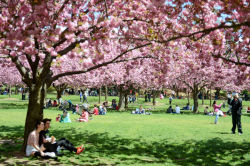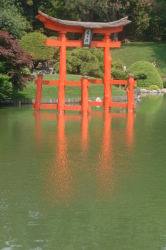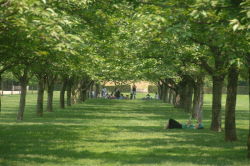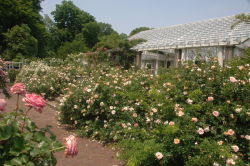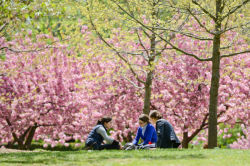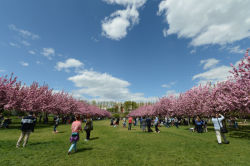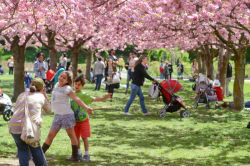Brooklyn Botanic Garden
Brooklyn Botanic Garden
Originally a marshy wasteland, the Brooklyn Botanic Garden has been transformed into one of New York City’s most beautiful parks. The Wisconsin Iceberg that shaped Long Island, Manhattan, and the Bronx millions of years ago gave this land its unique knob-and-kettle terrain of small ponds and hills by carving depressions in the soil.
Brothers Frederick Jr. and John Charles Olmsted (sons of Prospect and Central Park designer Frederick Law Olmsted) designed the original Brooklyn Botanic Garden. The present garden is largely the product of Harold Caparn, the landscape architect who took charge of the project in 1912. Caparn saw the garden as an artistic and educational facility. Borrowing a page from nature, he let the Brooklyn Botanic Garden organically grow over the course of decades, adding sections as he could and refurbishing others when needed, until it included over 13 separate gardens, buildings and museums when he left it in 1945.
The Native Flora Garden, established in 1911, is one of the Brooklyn Botanic’s oldest gardens. It displays plants growing within a 100-mile radius of New York City. The Children’s Garden, an educational center designed to teach children about plant life, opened in 1914. Takeo Shiota designed the Japanese Hill-and-Pond Garden in 1915 with a $13,000 gift from Arthur T. White, one of the gardens prominent benefactors who contributed $25,000 to the City’s matching fund to develop the Brooklyn Botanic in 1909. The Japanese Garden’s pond is set in one of the pools formed by the Wisconsin Iceberg. The Plant Family Collection bordering the Japanese Garden features various types of ferns, conifers, gingkoes, magnolias, elms, oaks, walnuts, heath, roses, legumes, honeysuckle, daisies, and monocots.
1917 was somewhat of a watershed year for the Brooklyn Botanic. The Brooklyn Botanic Garden Auxiliary was formed, the Rock Garden was constructed using glacially shaped boulders found during the garden’s initial construction, and the Louisa Clark Spencer Lilac Collection, featuring over 150 species of lilac, was completed. The Lily Pool Terrace was constructed in 1921, and in 1925 the Shakespeare Garden, featuring plant-life mentioned in the works of author William Shakespeare, was finished. The Cranford Rose Garden, completed in 1928, holds over 1,000 types of roses and the Magnolia Plaza, planted in 1932 along the Lily Pool Terrace, features 17 species of magnolia; both were designed by Harold Caparn. The nearby Steinhardt Conservatory includes the Bonsai Museum, the Warm Temperate Pavilion, the Tropical Pavilion, the Trail of Evolution, the Aquatic House, the Desert Pavilion, and the Palm House.
Works Progress Administration (WPA) labor was used to build the 1938 Herb Garden, a Caparn design taken from a 1577 Elizabethan knot garden. The Italian-style Osborne Garden was also constructed with labor from the Civil Works Administration and the WPA in 1939. The Kwanzan cherry trees (Prunus serrulata) along the Cherry Esplanade were planted in 1941, and the Fragrance Garden, designed by Alice Recknagel Ireys in 1955, was the first public garden designed for the visually impaired. The Brooklyn Union Gas Company donated the Celebrity Path in 1985 and the Urban Composting Project began in 1993. Most recently, the Discovery Garden opened in 1996.
The City of Brooklyn acquired the site for the Brooklyn Botanic Garden, bounded by Eastern Parkway, Empire Boulevard, Flatbush Avenue and Washington Avenue, in the Prospect Park purchases of June 15, 1864. The eastside land went unused for several years until the New York State Legislature established the Botanic Garden in 1897. The architectural firm of William Rutherford Mead, Charles Follen McKim, and Stanford White designed the Administration Building as well as the adjacent Brooklyn Museum of Art. The site was known as Institute Park when the museum opened in 1902. Management of the garden was assigned to the Brooklyn Institute of Arts and Sciences in 1910, and the Brooklyn Botanic Garden opened to the public on May 13, 1911.
Through its history, the Brooklyn Botanic Garden has been carefully maintained and developed. It separated from the Brooklyn Institute of Arts and Sciences in the 1970s, and an independent administration now operates and maintains the botanic garden. The Rock Garden was refurbished in 1992 with boulders from Westchester County and, in 1993, the Lily Pool Terrace was renovated. The Fragrance Garden was restored in 1995, as was the soil of the Cranford Rose Garden in 1996. The Japanese Garden underwent a major restoration in 1999 and 2000 with funding from the Brooklyn Delegation of the New York City Council, the New York State 1996 Clean Water/Clean Air Bond Act, Independence Community Foundation, and the Brooklyn Botanic Garden Auxiliary.
Check out your park's Vital Signs
Clean & Safe
Green & Resilient
Empowered & Engaged Users
Share your feedback or learn more about how this park is part of a
Vital Park System

